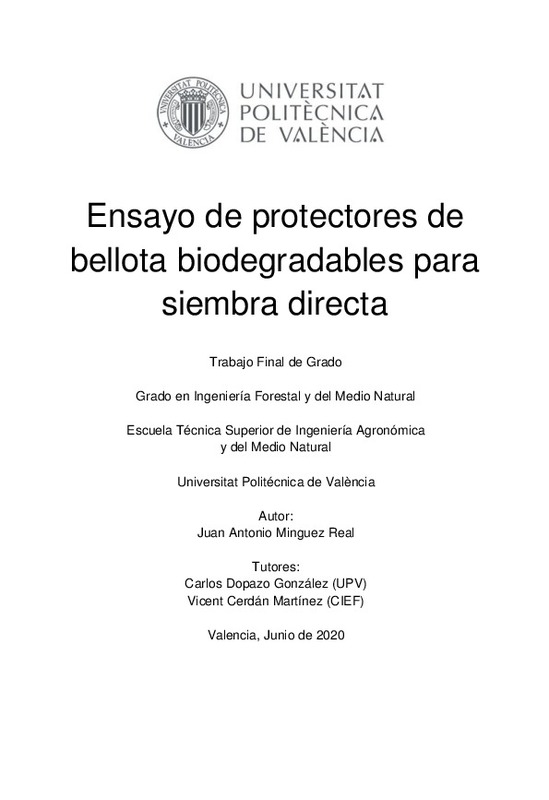|
Resumen:
|
[ES] El presente trabajo se ha desarrollado a partir de mi experiencia en el Centro de investigación y Experimentación Forestal (CIEF), en él se estudia la eficacia de un protector impregnado de repelente, que proteja las ...[+]
[ES] El presente trabajo se ha desarrollado a partir de mi experiencia en el Centro de investigación y Experimentación Forestal (CIEF), en él se estudia la eficacia de un protector impregnado de repelente, que proteja las bellotas de siembra, de la depredación de micromamíferos roedores y la depredación de los jabalíes.
El experimento se ha llevado a cabo realizando distintos ensayos que agruparemos en dos bloques. Un primer bloque se realiza en el vivero, donde se realizan tres ensayos. En el primero se ha comprobado que el tratamiento repelente no influye en el proceso de germinación, con un 86% de capacidad germinativa. Un segundo ensayo donde se han visto los posibles efectos del protector de caña sobre el desarrollo morfológico de los brinzales, en el que solamente un 15% de estos no estarían afectados en su futuro desarrollo. Y el tercero, en una parcela agrícola del vivero, donde se ha realizado una réplica del ensayo en monte.
El segundo bloque se ha realizado en el monte, se han llevado a cabo tres réplicas en tres parcelas de la Sierra Calderona, denominadas Puntal de la Vella, Fuente del Sapo y Masía de Tristán, donde pretendemos contrastar la eficacia del protector y del repelente frente a la depredación. Para estudiar las posibles sinergias o antagonismos entre los dos tratamientos, se ha elaborado un plan factorial 2² (factor repelente, presente o ausente y factor parcela, presente o ausente), con 80 pruebas por parcela. Los resultados de estas parcelas se han evaluado mediante un análisis Gi-2.
Los resultados obtenidos tras el análisis nos muestran que el repelente no influye negativamente sobre la germinación y ante la depredación por el jabalí, es indiferente la presencia del repelente. Y en cuanto al protector, no se ha podido comprobar si es efectivo contra el ratón, ya que no se ha observado signos de depredación de los ratones. Además, se ha observado que el protector influye negativamente en el establecimiento del brinzal, probablemente debido a un error de diseño.
[-]
[EN] The present work was based upon my experience in the Centre for Forestry Investigation & Experimentation (CIEF) and investigates the effectiveness of a repellant-impregnated protector in protecting acorn seedlings ...[+]
[EN] The present work was based upon my experience in the Centre for Forestry Investigation & Experimentation (CIEF) and investigates the effectiveness of a repellant-impregnated protector in protecting acorn seedlings from predation by rodents or wild boars.
The experiment comprised various tests that we will group into two blocks. The first block was carried out within a nursery and is made up of three tests. The first test verified that repellent usage does not influence the germination process, with germination capacity remaining at 86%. The second test looked at the effects of a sugarcane protector on the morphological development of the seedings; only 15% of the seedlings would not see future development affected. The third test was a replication of the field trial, carried out in an agricultural plot within the nursery.
The second block was made in the field, with trials replicated in three areas of the Sierra Calderona ¿ Puntal de la Vella, Fuente del Sapo and Masía de Tristán ¿ with the intention of contrasting the effectiveness of the protector and repellant against predation. In order to study the possible synergies or antagonisms between the two treatments, a 2² factorial plan (repellent factor, present / absent; plot factor, present / absent) was developed with 80 tests per plot. The results of these plots have been evaluated using a Gi-2 analysis.
The results obtained from the analysis demonstrate that the repellant does not have a negative influence on germination; in relation to wild boar predation, the presence of the repellant is indifferent. In relation to the protector, it was not possible to verify effectiveness against mouse predation, as no signs of the aforementioned predation were observed. Additionally, it was found that the protector negatively impacts the establishment of the seedling, probably owing to an error in design.
[-]
|





![PDF file [Pdf]](/themes/UPV/images/pdf.png)


